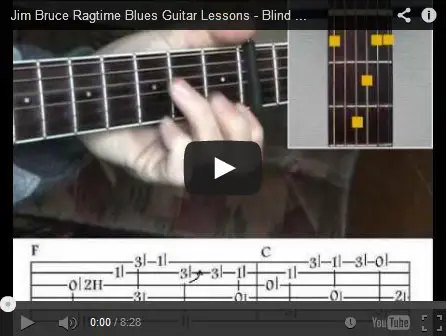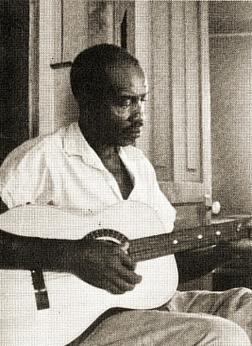Acoustic Blues Guitar Picking - Learning Blues Guitar
It almost
goes without saying that elementary finger picking is quite easy – you
strike one string with the thumb and the following one with a finger, or
pluck two or 3 strings in unison with thumb and finger(s)! I’ve noticed that a lot of,old school guitar masters simply applied one finger on their right hand– Doc Watson, Reverend Gary Davis, Scrapper Blackwell, Blind Boy Fuller, Floyd Council, Big Bill Broonzy, and the list goes on and on.
The right hand thumb can travel over to the treble strings to help out, which adds to the syncopation. We start to see that the right thumb is the driving force behind the greatest acoustic blues.
It can double the beat to reproduce the
heartbeat, strike off the beat , pluck two or more strings at a
time and create single string runs when used together with one of
the fingers (typically the index.) Reverend Gary Davis was a main
exponent of this fashion of picking .
Davis might perform with
picks or naked fingers, but preferred to use a large plastic thumb
pick and a steel finger pick steel pick on his index finger.
It creates a strong, penetrating effect which permitted his blues sound to be heard over traffic din in Harlem when he sang and performed on the busy street.
His stunningly rapid individual string runs picked with
thumb and finger are really tricky to replicate faithfully . Davis was
widely revered as a excellent blues guitar teacher. For the student
keen to learn the blues, the Reverend was sent from heaven.
Other
great players such as Doc Watson and Chet Atkins, had a clipped,
economical way of picking, but Doc utilizes a plastic thumb and finger
pick, whilst Chet used a plastic thumb-pick and bare finger nails. Doc
utilizes one finger of his picking hand, and Chet employed three (at
least).
In the late 50s and beginning of the sixties , youthful
students looked for the old blues guitarists and quite a few
of the old players started to play their guitars one more time,
either as performers or instructors.
As the years pass, they are now
thin on the ground , so it becomes far more hard to locate a real
original blues guitar picker who can play in the old way.
Over
the last 5 years, the sources accessible for the student guitarist
interested in finger picking the blues are incredibly varied . However,
this can additionally slow us up a little. How to begin? Where
to locate a master of the old style? What technique to follow,
blues from the delta or Piedmont ragtime blues?
How to begin? Where
to locate a master of the old style? What technique to follow,
blues from the delta or Piedmont ragtime blues?
Modern acoustic guitar lessons can be a little over-complicated and it seems that the formula " Fantastically Complex = Far better" even now holds true in a lot of quarters quarters.
Fortunately, some guitarists are searching a lot more in direction of the roots again in current years and more fans are looking for the authentic sound of acoustic blues guitar .
Going back
to the roots is the best way to learn how to play the blues.
Which
is not to say that these original blues guys couldn’t make some
incredibly complex sounds, but the sensation powering the fingers is
what it’s all about really.
A Texan blues legend, Lightnin’ (Sam)
Hopkins frequently performed a easy pattern in E, let’s say , with a
sturdy monotonic bass rhythm . At times he would double the beat and
the bass sound grew to become a heart beat.
Is there A Fast Track Method for Learning Blues Guitar?
I'll skip the obvious answers, like practicing 5 hours a day and wanting it so bad for most of the time its all you have in your mind - if you are really motivated, you'll be dreaming about the guitar as well!
Most people aren't in this category, but want to play some stuff reasonable well and have a good time.
A couple of things come to mind when thinking about progress on guitar. Such progress comes in spurts after you get to a certain level. Often it seems as though you are just stuck.
A good way of breaking through these times is to just let it go! That's right - just let it be. Don't play for some days (or weeks).
Whatever you fear, you won't suddenly 'lose it' if you don't touch a guitar for day or so! When you get back to it, you'll find you have new ideas and extra energy for exploring the next steps.
Someimes it's good to go backwards as well, simplifying what you are trying to do and search for that elusive blues feeling you're so crazy about.
The psychological aspects of guitar learning are also often overlooked. The focus of the mind is very powerful and actually produces physical results. Try it for a few weeks - see yourself playing a tricky piece perfectly as many times throughout the day as you can.
Last thing at night, focus on the piece - see and feel your fingers making the sounds - imagine the original blues man playing the piece. How did he feel about the song, about playing in public, about his life, his loves and his destiny? Try it and you'll be amazed!
Piedmont and Ragtime Blues Guitar Picking
 There's a whole group of South Carolina players that were a force in their own right and created music that was peculiar to the region. (Blake was from Florida, and ended up in Chicago where he made his fame.)
There's a whole group of South Carolina players that were a force in their own right and created music that was peculiar to the region. (Blake was from Florida, and ended up in Chicago where he made his fame.) Date: 2013-10-01
Category: Music
dupree-and-betty.mp3
Back To Blues Guitar Lessons Welcome Page And Site Menu
Copyright (c) Youtune Records
Jim Bruce
Videos
Privacy Policy

